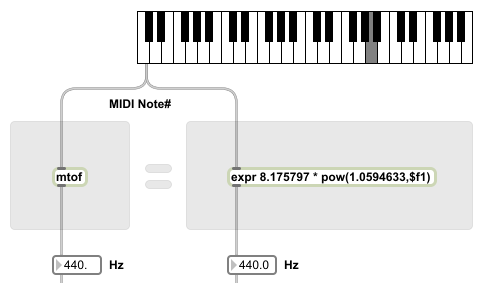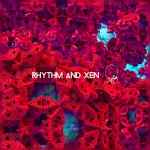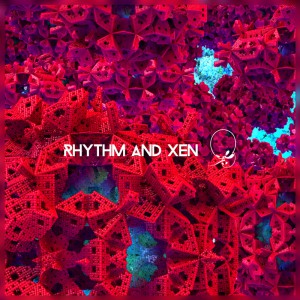Just hit play and then keep reading.
ILEVENS describe themselves as a psych-pop band.
So what, you say? Well compared to other acts who are working within this style, you might (if you’re like me) notice something you just can’t put your finger on with the sound. Something sounds almost brighter, deeper, richer… What is that?
Take a closer look at the guitar. There are way too many frets on that damn thing. What’s going on?
Well ILEVENS are playing in a new intonational system that abandons traditional musical values. In other words, this music is microtonal. They’re using a system with 22 steps in an octave.
Shit, somebody has finally done it! Somebody has finally made microtonal music that’s not all theory and MIDI trumpet sounds!
ILEVENS’ frontman Brendan Byrnes isn’t just the handsome face of the band but also a bit of a mastermind for bringing this group and this sound into existence.
You see, it’s now very clear that having depths of knowledge about microtonality (read: the future of music) isn’t enough to get people interested in this style. You need to have the ability to write clearly, play with enthusiasm, and have fun. ILEVENS do this to such a high degree that it becomes “music” first and foremost and “a whole new paradigm of musical intonation” second. That’s the way things should be. That’s how we can show the world what microtonal music can do.
Brendan also made the rather mesmerising Micropangaea album a couple years ago, so if you’re getting into ILEVENS then this is recommended listening too.
I will be live-streaming another music making session this weekend! Tune in here:
http://www.twitch.tv/sevishmusic/
Sunday 2:30am UTC (Saturday 10:30pm EST)
This time I will be attempting to start a new track, so you’ll get to see my creative process from the beginning. We’ll kick off with scale creation and I’ll be creating a new musical tuning specifically for this piece. Make sure you sign up for a free Twitch.tv account so that you can get involved in the live chat.
It will be my second time doing a live stream. First time had a few technical problems, but next time things will be smoother. Bits of the first session have been archived on the above link in case you want to catch up.
My piece Guano Sequence was featured in a compilation album from the music blog Can This Even Be Called Music?
There are some really far out sounds on this album, so check it out! Can This Even Be Called Music promotes unique underground bands and genres by reviewing their music, art, and lyrics. Dave Tremblay, who founded the blog, is even a microtonal musician in his own right!
Last weekend I put on a live stream about making microtonal music in Ableton Live. While there were a few technical issues, I did manage to get my head into a spacey improvisation in the Bohlen-Pierce scale. The improvisation was played with my AXiS-49 by C-Thru Music (a company which unfortunately went out of business recently).
The Bohlen-Pierce scale provides an exciting alternative to the Western 12-tone equal temperament. Instead of using major (4:5:6) and minor (10:12:15) triads as the basis of its harmony, it uses 3:5:7 and 5:7:9 “triads”. The ratios refer to the frequencies of the notes which form its harmony. To my ear, BP is spaced out, sparse and atmospheric. It sounds alien but it makes sense in its own weird way.
Actually the chords that are in the background of my improvisation don’t use the 3:5:7 or 5:7:9 chords, but to my ear they still capture that unmistakable BP sound. Definitely a great xenharmonic scale to go back to now and again.
If you want to hear more, you’ll find a plethora of Bohlen-Pierce recordings on YouTube.
For more reading, check out the Bohlen-Pierce site!
And just for good measure, here’s another Bohlen-Pierce track that I wrote way back in 2010.
Just for fun I’ll will be live streaming my next music making session. Tune in here:
http://www.twitch.tv/sevishmusic/
Sunday 2:30am UTC
There will be live chat so we can discuss approaches to microtonal composition, sound design, audio engineering etc. Just follow the link to start watching. You’ll need to sign up for a free Twitch.tv account to get on the chat, and I hope you’ll do that so I can have some company while making noises.
I’ll be working on some new stuff, and maybe also creating some synth sound designs to be used later. I’m happy to load up the songs from Rhythm and Xen if you want to see how they were made. Never tried anything like this before so let’s do something new!
I’ve been gradually releasing all the tracks from ‘Rhythm and Xen’ on Soundcloud and YouTube since May. Now you can finally stream the whole album for free on either service! So pick one and listen to the whole thing uninterrupted as much as you like. :)
If you wish to support my work, please consider buying Rhythm and Xen from Bandcamp. I’ve been blown away by all the support so far, and happy that people are enjoying these sounds. I can’t wait to get back to writing some new stuff again.
UPDATE February 2017: You can now stream this Rhythm and Xen on Spotify. While you’re there, please follow my Sevish artist page on Spotify!
Over time I’ve noticed that I get asked this question more and more:
How do I start writing microtonal music?
This always comes from musicians who have enjoyed listening to microtonal music, and are comfortable composing in their own twelveness, but haven’t found the courage or motivation to start experimenting for themselves.
My answer is always the same.
First you gotta get set up with the right tools for the job. In a few hours or less you can set up some free microtonal synths.
The real thing to do, is get ANY microtonal scale up on your instrument, and then play. It’s fine to choose the scale at random. Keep playing until you find something you like about it. Start building up layers over this. This helps you to find how parts of the scale connect with other parts.
After you become a little comfortable with the scale, just try out a different scale and you may find something even better than before. Then over some days or weeks try another and another. Just experiment.
Your composition skills (or lack thereof) shouldn’t hold you back during this time. This is because when you write microtonally you’ll have to discard a lot of the ‘rules’ you already know. Old habits become unable to reinforce themselves. That’s kinda the point of going to all this effort.
Nobody can guide you through microtonal music the same way that they guide you through playing an instrument or learning music theory. There is no established method, instead you get a bazillion competing schools of thought about how to organise and play from the infinite number of scales that are possible. A well-trodden path simply doesn’t exist for you – you make your own path or you don’t enter this forest at all. But if you do make it inside, you’ll find the sweetest fruits. So it’s totally up to you to start trying.
After going through many creative cycles you get to learn about what scales work for you. If you’re the studious type you may be able to read tuning theory concepts and slowly start to grasps small aspects of it.
For me, it was a lot of listening, and a lot of loading randomly-selected scales into my synth to see what I liked and didn’t. A whole lot of failed experiments, and a few that worked. Reading about microtonal tuning theory is overrated, but it can be a starting point for finding interesting scales. If you have nothing more than a good ear, perhaps it’s you who will excel the most in this unknown territory.
And that’s how to start writing microtonal music. It didn’t take anything more than getting your toes wet with a few randomly-selected microtonal scales.
The mtof object can take a MIDI note number and output the frequency of that note in standard 12-tone equal temperament tuning (aka 12-EDO). But what if you want to get away from this musical dogma? How about we start to explore say 13-EDO, 7-EDO, 24-EDO, or 41-EDO with Max/MSP?
Equal temperament on Wikipedia
Equal temperament on the Xenharmonic Wiki
Some years ago I wrote an expression that could quickly be dropped into any Max/MSP synth and then play microtonal equal temperaments. It’s a more generalised version of mtof and I want to share that with you today. It’s an mtof-killer!
First let’s take a quick look inside the mtof object and see how it works. Really, mtof just performs one simple expression.

Here is my mtof-killer expression in all its beasthood:
Nasty, right?
Copy and paste this code into Max/MSP and continue along with this tutorial.
----------begin_max5_patcher---------- 882.3ocyXE0aaBCD94To9evh0GZlxRwfwD1aapaR8gsIsWampHfSp6.Cy3zl 1p0e6yXGRnYg.AkRSdvN9riuu6ymu6bd53i5YLNYNIy.7Qvkfd8dRJomRVtj dEB5YD6OOHxOSsPCF49jw2ZLXwbBxbgRtfSedozjYhHhP7PJQu4FYzoL+HCv uJVwjDlf4Gql23SbpbxhongJgRs7AK7RorYwTlbSUnvtPZpuH3FJa50bRfPq KanyPyA.aSq7NDNu0xbn4JcK2JM.U6ErLjxnOpfDT9iUh+6wGk2K6FzXJZpO kUOWL.XPYhRTRY6FsY61pA1sMJuCpGYgp1vKsYb4Igfvulv7GGovY6sdxig9 AOuwSSq1aUiTmiHmh1pLp1i6IQIxsp5iM479h7Ssw9ro6tmLby1Nrda2xEl2 4XVmm71OP26t4RkOlvqlvx8t+e5RZ6zXIOuNjpmBg0QgRzUr0PK2sPrXOUrA 3H6WShckbdruRynCTmSuc22zAiGZK+3hd04wCTRyc2IMDxbHV9wBujzrcOvH semEQCav05Wl6JkSxHLguflvJYvJOBScZIU.bG6xFZI1zo0oFbvUt+cR9tfj 3XRNmrdEQ+jLgvIr.B3aWb9EfumHHua4phnLRPxLl3EHaBe5XEZFtkXifOmD EtIOR6Z7HyQ1syxDzIz.0IUc9qXWOUbRzn7N8.6sTQw92arAj6W4j+LS9sGd U4Vq8M253fVE.8.jf+x4+vX+PcsnxGjq6tGnrCImN5B8nQsnnQKUfPnKZnir T42.WppdgHYdJGb5ISrAmARStGbpt05pqFHKv8rSlX0W90Snn98Aueqq.1u5 zSaMOdkLMthXmnFTdNTUdts2avKMS8YjUEmLdZPRTBe8TuEMdlPO7FS9Bwsv OyT+NS88RDVwEPSul+zL85TWbV++fPou7IVy3yRlwCJNoKdnLnjFCIxPvrkA fub0COKupanggD1K79CoY4kBDVSs.MFX4NTM.XvNGX6.iA2JvhogoIxp.yJh 6nB3X6piVKeLPwnR5ZeaK3FYKntmjgMBX3NGXvFALkyqcmBLuFiKqNEWtMFW vNEWNMFWls3VLbQNsRiZ1s3Ewz8SSuivyVfFsUHybcqN4DdfdLkoGqSyXvI2 QK9I5+fWCetLsiPlyYFWmEe9HrgbFkBkM+yHSxvn -----------end_max5_patcher-----------
The ‘EDO’ value sets what equal tempered tuning you want. So a setting of 5 gives you 5-EDO, a setting of 34 gives you 34-EDO.
‘Reference Frequency’ is the standard pitch for the scale. Usually in Western music A = 440 Hz. You can also use 432 Hz if you believe in crystal healing and reptilian world leaders.
‘Reference MIDI Note#’ is the MIDI note to be tuned to the reference frequency (above). This could be MIDI note 69 if you want to tune to middle A, or MIDI note 60 if you want to tune to middle C.
For starters, try 5 for the EDO value, 440 Hz for the reference frequency and 69 for the reference MIDI note number. Have a play on the keyboard. It’s a cool sounding pentatonic scale, right?
If you played with my example patch and got it working, then you don’t need to read this section. Just start using it in your projects and have fun exploring equal temperaments.
But if you absolutely must know how this magic is done, then keep reading! (Warning: I will assume that you already understand how to make expressions with the expr object).
Let’s look back at the original mtof expression, try to understand it, and then try to generalise it.
Output frequency = 8.175797 * pow(1.0594633,$f1)
Note that pow(a,b) is just the expr object’s way of saying a^b.
8.175797 is the frequency (in Hz) for MIDI note 0.
$f1 is the MIDI note number being played.
1.0594633 is the size of the smallest step size in 12-EDO. It is the value of a semitone.
Therefore an mtof object has this general structure:
Output frequency = Frequency of MIDI note 0 * pow(step size,MIDI note number)
Let’s start by swapping the step size of 1.0594633 with the step size from any n-EDO we want. But how do we calculate the step size? For n-EDO, it’s calculated like this:
step size of n-EDO = pow(2,1.0/n)
So let’s bring that into our in-progress generalised mtof:
Output frequency = Frequency of MIDI note 0 * pow( pow(2,1.0/n),MIDI note number )
That’s great, but unless you want MIDI note 0 to always be equal to 8.175797 Hz, how will we go about tuning our scale up to some standard pitch? Well first we need to know what our standard pitch is (aka reference frequency) and we also need to know what MIDI note number to assign that reference frequency to. Once we know these, we work backwards to find the frequency at MIDI note 0.
If our reference MIDI note number is higher than 0, then the frequency at MIDI note 0 will always be lower than the frequency at the reference MIDI note number. In fact:
Frequency at MIDI note 0 = reference frequency / pow(step size,reference MIDI note number)
We can re-use the step size calculation from before and insert it into the above calculation for MIDI note 0 frequency:
Frequency at MIDI note 0 = reference frequency / pow( pow(2,1.0/n),reference MIDI note number )
Above, we’ve just found a way to calculate the frequency at MIDI note 0 for any reference frequency assigned to any MIDI note number for any EDO of size n. That’s the entire left side of the mtof-killer worked out. So let’s bring alllll of this together:
Output frequency = Frequency of MIDI note 0 * pow(step size,MIDI note number)
= (reference frequency / pow( pow(2,1.0/n),reference MIDI note number )) * pow( pow(2,1.0/n),MIDI note number )And finally we replace these English-language variables with integers and floats in expr format, such that:
$i1 = MIDI note number from the keyboard
$f2 = n-EDO
$f3 = reference frequency
$f4 = reference MIDI number
($f3 / pow ( pow (2,1.0/$f2),$i4)) * pow ( pow (2,1.0/$f2),$i1)
Well done if you kept up! I hope that explains how this expression alone can allow you to play microtonal equal tempered tunings in your Max/MSP projects.
UPDATE: Homebrewed methods like my one above are often inefficient. A commenter Toby noted:
This does the same thing in a simpler way:
expr $f3 * pow(2,($f1-$f4)/$f2)
If you need more power than this, for example you wish to create scales with arbitrary and variable step sizes, or you wish to play just intonation scales, then you should read How to play microtonal scales on a Max/MSP synth.

Thanks for listening.
Update: This compilation album has now been released! Check out Next Xen now and download it for free from split-notes. Thanks to everybody who got involved!
split-notes is a digital record label for microtonal music. We have a new compilation album in the works – and we are asking for artists to submit pieces! If you’re a xenharmonic/microtonal composer (or even if you’re not), this is a great opportunity to get heard.
More information: http://split-notes.com/comp2015.php
Let’s see if this project can rouse split-notes from its recent dormancy!
It goes without saying (actually maybe it doesn’t) that if you want to make microtonal music, you need to have the right tools. For my album Rhythm and Xen I found the perfect set of tools that worked for me to get the sound that I wanted. And all while bending notes like a madman.
Stream and download Rhythm and Xen
First the machine: I produced half the tracks on a home-built desktop computer running Windows 7. The other half were produced on an Acer laptop running Windows 8. That should tell you there’s no need to get fancy and expensive, just grab a computer made within the last 5 years and start writing.
My DAW of choice is Ableton Live 9. I used to be an FL Studio user – a really common phrase for my generation – but when I picked up Ableton Live I preferred the workflow and the base functionality. There was no looking back.
As for the default synths that come with Live, throw ‘em out. They can’t be microtuned, so they’re only good for making music that everybody else makes.
For me, the key to making microtonal music in a DAW is to find some microtunable VSTs that you like the sound of. So here are the 5 VSTs I used in Rhythm and Xen:
I love the sound design potential of this synth, and the VA waveforms sound nice for a digital synth.
FM synthesis built from the ground up to get spectrally microtuned sideband partials… what’s not to like? And if you have no idea what I’m talking about, it’s just a good FM synth. :)
Virtual analog with some weird characteristics, quirky yet bold.
It’s a SoundFont player. When you’re craving some 12-bit sounds.
An affordable orchestral sound bank, nuff said. Sadly, the more I work with GPO4, the more I can recognise it from a mile off. So now that Rhythm and Xen is complete I’m gonna retire this one.
As far as VST instruments go, these 5 were all I needed. Although, I did create a couple of my own sound generators in Max/MSP to fulfil other needs. But if you’ve seen my downloadable music resources then you already know what those are.
FX wise, I just love the collection from Variety of Sound. NastyDLA is all over this record, and I used some of their bus compressors in mastering. These plugins are amazing and free!
Oli Larkin’s Endless Series v3 is a really unique effect which can generate Shepard tones, endlessly rising tones. But the killer bit is, it can do endlessly rising or descending phaser and flanger effects too. You can create a sense of urgency doing this (great risers), or else just come up with some cool sound designs.

Download the album: https://sevish.bandcamp.com/album/rhythm-and-xen